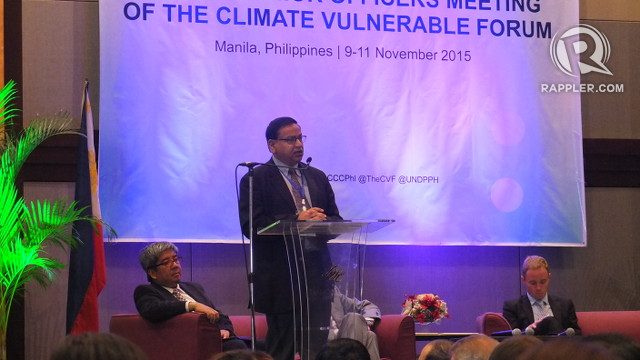SUMMARY
This is AI generated summarization, which may have errors. For context, always refer to the full article.

MANILA, Philippines – “Even if it may not be achievable, 1.5°C is the right goal to have. It is what we should, as leaders, agree to in Paris.”
These were among the sentiments voiced by Dr Saleemul Huq, a renowned Bangladeshi climate expert and lead author of UN-commissioned scientific climate change reports during a summit held in Manila, Philippines on Monday, November 9.
In strong language, he appealed to the representatives of 20 of the most climate-vulnerable countries to continue pushing for the world to adopt a 1.5°C goal instead of the more accepted, and easier, 2°C target.
Huq, one of the lead authors of the Intergovernmental Panel on Climate Change (IPCC) reports said that while aiming to keep warming below 2°C will significantly reduce the likelihood of threats like sea level rise, freak typhoons, and catastrophic drought, certain countries in the world will still suffer.
“While 2°C as a long-term goal is safe for many countries and many peoples, it is not safe for all countries and all peoples. And so if we want all countries and all peoples to be safe, we need a 1.5°C goal,” he said.

The 1.5°C target is the main advocacy of the 20 countries composing the Climate Vulnerable Forum (CVF). These 20 developing countries from the Pacific, Africa, Mediterranean, South America, and Asia are already suffering the most from climate change.
‘We cannot protect you’
Huq warned that if the much-awaited UN climate change conference sticks to the 2°C goal, the world would have failed these 20 vulnerable countries.
“The global leadership meeting in Paris that adopts a 2°C goal will knowingly be writing off many people and many of those people are from the countries represented here and saying to them we cannot protect you because it’s too difficult for us to make the emission cuts that are necessary to protect you, the most vulnerable people on planet earth. That’s a bad decision for world leaders to be making,” he said.
Some rich countries from the G77+China bloc oppose the 1.5°C because it is much more difficult to achieve. It would require even larger carbon emission cuts which is perceived to slow down economic growth.
The current carbon emission cuts pledged to the UN are not even enough to keep warming to 2°C, according to various analyses of the submitted Intended Nationally Determined Contributions. What more if the goal is to limit warming to just 1.5°C?
But Huq said this difficulty should not stop the world from adopting the “morally correct” goal. (IN PHOTOS: The faces of climate change)
“The reason for pushing the 1.5°C goal is not whether it’s feasible and possible – we know it’s going to be difficult – but whether it is morally correct or not.”
Safer ‘guardrail’
A review commissioned by the UN concluded that a 1.5°C goal would be a safer “guardrail” especially against risk from ocean acidification and extreme weather events.
It also showed that the difference between 1.5 °C and 2°C of warming “is significant for highly temperature-sensitive systems, such as the polar regions, high mountains and the tropics, as well as for some other regions, in particular low-lying coastal regions.”
The more ambitious temperature ceiling would better safeguard food security in places like Africa where crop yields are at greater risk from climate disruption than in other places in the world.
Other key benefits if the world were to adopt the 1.5°C goal include the following, according to the study:
- Most terrestrial and marine species would be able to follow the speed of climate change
- Up to half of coral reefs may remain
- Sea level rise may remain below 1 meter
- Some Arctic sea ice may remain
- Ocean acidification impacts would stay at moderate levels
- More scope for adaptation would exist, especially in the agricultural sector
The cost
But there is a cost to this more ambitious aim.
Though the technologies required for the 1.5°C scenario are the same for 2°C, they “need to be deployed faster, and energy demand needs to be reduced earlier,” reads the report released last June.
Some technologies and policies required for the 1.5°C pathway may also “negatively impact poverty reduction efforts.” adds the review.
Despite these challenges, the 20 vulnerable, poor countries won’t be starting from scratch, stressed Huq.
These countries already have their wealth of experience handling climate threats.
“Not only are the vulnerable countries vulnerable, they are actually now leading in some areas compared to the rest of the world in terms of how to tackle the problem of climate change,” he said.
He called on the countries to share their best practices with each other and the rest of the world. He pointed to the Philippines which he said has become “very well adapted to normal typhoons.”
“We know that the Philippines is well adapted and we can learn from the Philippines,” he said.
His country Bangladesh, meanwhile, has become an expert in implementing community-based adaptation to climate impacts.
Huq stressed that, far from being mere victims, the vulnerable countries can act now.
“We have enough capability and resources to do something. We cannot wait for assistance for us to take the issue forward.” – Rappler.com
Add a comment
How does this make you feel?
There are no comments yet. Add your comment to start the conversation.